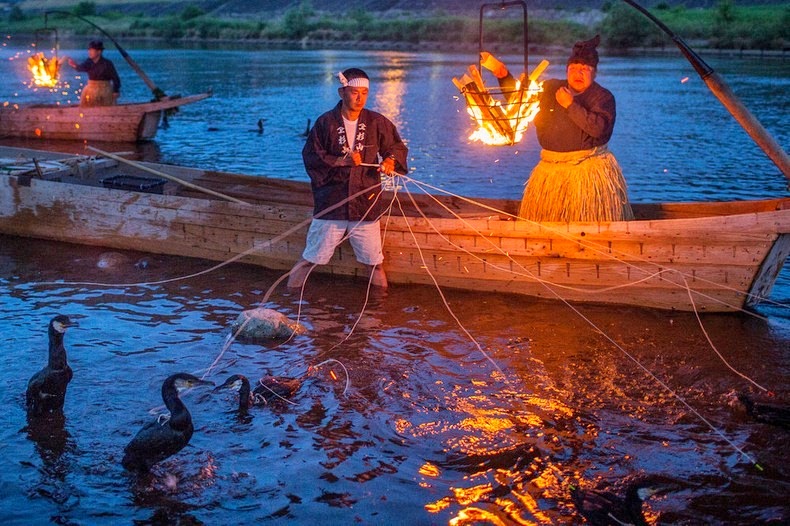Cormorants are a family of sea birds whose diet consist mostly of fish. These birds are masters in fishing – they wait for their prey on sea shores or by the side of rivers, and at the right moment dive underwater, propelling themselves with their wings and feet, and catch fish with their specially designed beaks. In ancient Japan and China, fishermen have learned to keep and train these birds to help them catch fish in rivers. This is known as cormorant fishing or “ukai” in Japan. It is still practiced in select places in Japan, particularly in the Nagara River in Gifu Prefecture, where the ancient art has a long history going back to more than 1,300 years.
Photo by Chris McGrath
Cormorant fishing takes place under darkness during the twilight hours. A group of fishermen, working from long wooden boats, lead about a dozen cormorants on leashes who swim alongside the boat and dive under the water to catch fish by swallowing them whole. A snare is tied near the base of the bird's throat, which allows the bird only to swallow small fish. When the bird captures and tries to swallow a large fish, the fish is caught in the bird's throat, which is later retrieved by the fishermen when the cormorant returns to the boat. Each bird can hold up to six fish in its throat at a time.
Each boat has a large fire that hangs from its bow to provide light for the boatmen to steer and the birds to fish by. Although more efficient methods of catching fish have been developed, cormorant fishing is still practiced to keep the tradition alive and also to serve as a tourist attraction.
Cormorant fishing requires great skills of the fishing masters, because of which they have been conferred the official title of “Cormorant Fishermen of the Imperial Household Agency,” a hereditary title that is passed on from father to son.
The use of cormorants for fishing on the Nagara River began over 1,300 years ago, originating as a way for people to feed their families. When cormorant fishing came under the auspices of the Imperial Household Agency, the Nagara River became a protected river, which keeps it clean and healthy, allowing cormorant fishing to continue through the ages. The birds have become such a part of Japanese lore, that they have given rise to the expressions such “swallow whole like a cormorant” or “accept without questions,” because they can swallow fish whole without choking on the scales.
Cormorant fishing was once a profitable industry. Eventually, the number of fish caught by cormorants began to decrease as other fishing methods and modern transportation became available. Cormorant fishing still continues in the city of Gifu today and draws people from around the world.

Photo by Chris McGrath
Photo by Chris McGrath
Photo by Chris McGrath
Photo by Chris McGrath
Photo by Chris McGrath
Photo by Chris McGrath
Photo by Chris McGrath



























OK, Thx
ReplyDelete